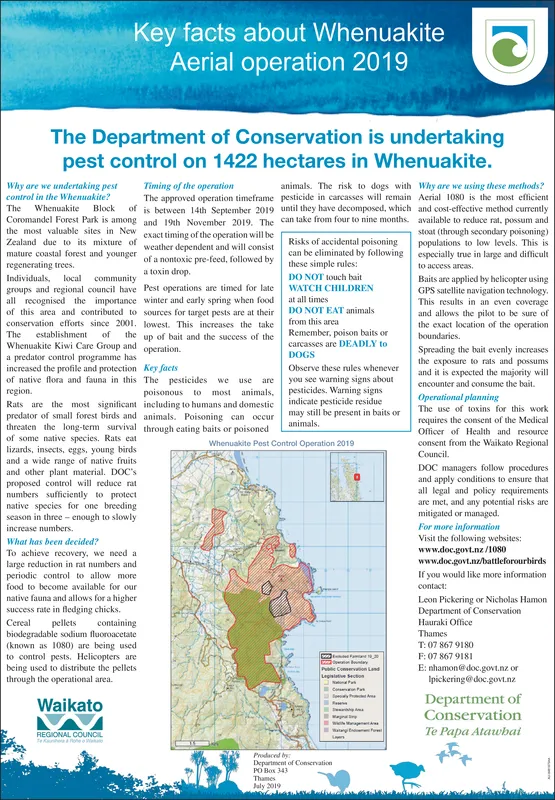Advertisement

-
Published Date
August 2, 2019This ad was originally published on this date and may contain an offer that is no longer valid. To learn more about this business and its most recent offers, click here.
Ad Text
Key Aerial operation 2019 facts about Whenuakite The Department of Conservation is undertaking pest control on 1422 hectares in Whenuakite. Why are we undertaking pest control in the Whenuakite? Timing of the operation animals. The risk to dogs with Why are we using these methods? The approved operation timeframe pesticide in careasses will remain Aerial 1080 is the most efficient Whenuakite Block of is between 14th September 2019 until they have decomposed, which and cost-effective method currently Coromandel Forest Park is among and 19th November 2019. The can take from four to nine months. available to reduce rat. possum and the most valuable sites in New exact timing of the operation will be Zealand due to its misture of weather dependent and will consist mature coastal forest and younger of a nontoxic pre-feed, followed by regenerating trees The stoat (through secondary poisoning) populations to low levels. This is can be eliminated by following especially true in large and diflicult Risks of accidental poisoning these simple rules: DO NOT touch bait to access areas a toxin drop. local Baits are applied by helicopter using GPS satellite navigation technology This results in an even coverage and allows the pilot to be sure of the exact location of the operation boundaries Spreading the bait evenly increases the exposure to rats and possums and it is expected the majority will encounter and consume the bait community groups and regional council have Pest operations are timed for late al recognised the importance winter and early spring when food of this area and contributed to sources for target pests are at their conservation efforts since 2001. lowest.. This increases the take the Individuals WATCH CHILDREN at all times DO NOT EAT animals from this area Remember, poison baits or carcasses are DEADLY to Whenuakite Kiwi Care Group and of bait and the success of the a predator control programme has peration. The establishment of DOGS increased the profile and protection Key facts of native flora and fauna in this The pesticides we use region. Rats are the most significant including to humans and domestic predator of small forest birds and animals. Poisoning can threaten the long-term survival through eating baits or poisoned Observe these rules whenever you see warning signs about pesticides. Warning signs indicate pesticide residue may still be present in baits or animals are poisonous to most animals Operational planning The use of toxins for this work r requires the consent of the Medical Officer of Health and resource consent from the Waikato Regional Council of some native species. Rats eat lizards, insects, eggs, young birds and a wide range of native fruits and other plant material. DOC's proposed control will reduce rat numbers sufficiently to protect native species for one breeding season in three- enough to slowly increase numbers Whenuakite Post Control Operation 2019 DOC managers follow procedures and apply conditions to ensure that all legal and policy requirements are met, and any potential risks are mitigated or managed. For more information Visit the following websites: www.doc.govt.nz/1080 www.doc.govt.nz/hattleforourbirds What has been decided? To achieve recovery, we need a large reduction in rat numbers and periodic control to allow more If you would like more information contact food to become available for our native fauna and allows for a higher success rate in fledging chicks Leon Pickering or Nicholas Hamon Department of Conservation Cereal pellets biodegradable sodium fluoroacetate (known as 1080) are being used to control pests. Helicopters are being used to distribute the pellets through the operational area. containing Hauraki Office Thames T: 07 867 9180 F:07 867 9181 E: nhamon@doc.govt.nz or Ipickering@doc.govt.nz y P Comeryon Land Legit cto P Department of Conservation Waikato w a Te Papa Atawbai REGIONAL COUNCIL oe Prodaced by Department of Conservation PO Box 343 Thames July 20194 Key Aerial operation 2019 facts about Whenuakite The Department of Conservation is undertaking pest control on 1422 hectares in Whenuakite. Why are we undertaking pest control in the Whenuakite? Timing of the operation animals. The risk to dogs with Why are we using these methods? The approved operation timeframe pesticide in careasses will remain Aerial 1080 is the most efficient Whenuakite Block of is between 14th September 2019 until they have decomposed, which and cost-effective method currently Coromandel Forest Park is among and 19th November 2019. The can take from four to nine months. available to reduce rat. possum and the most valuable sites in New exact timing of the operation will be Zealand due to its misture of weather dependent and will consist mature coastal forest and younger of a nontoxic pre-feed, followed by regenerating trees The stoat (through secondary poisoning) populations to low levels. This is can be eliminated by following especially true in large and diflicult Risks of accidental poisoning these simple rules: DO NOT touch bait to access areas a toxin drop. local Baits are applied by helicopter using GPS satellite navigation technology This results in an even coverage and allows the pilot to be sure of the exact location of the operation boundaries Spreading the bait evenly increases the exposure to rats and possums and it is expected the majority will encounter and consume the bait community groups and regional council have Pest operations are timed for late al recognised the importance winter and early spring when food of this area and contributed to sources for target pests are at their conservation efforts since 2001. lowest.. This increases the take the Individuals WATCH CHILDREN at all times DO NOT EAT animals from this area Remember, poison baits or carcasses are DEADLY to Whenuakite Kiwi Care Group and of bait and the success of the a predator control programme has peration. The establishment of DOGS increased the profile and protection Key facts of native flora and fauna in this The pesticides we use region. Rats are the most significant including to humans and domestic predator of small forest birds and animals. Poisoning can threaten the long-term survival through eating baits or poisoned Observe these rules whenever you see warning signs about pesticides. Warning signs indicate pesticide residue may still be present in baits or animals are poisonous to most animals Operational planning The use of toxins for this work r requires the consent of the Medical Officer of Health and resource consent from the Waikato Regional Council of some native species. Rats eat lizards, insects, eggs, young birds and a wide range of native fruits and other plant material. DOC's proposed control will reduce rat numbers sufficiently to protect native species for one breeding season in three- enough to slowly increase numbers Whenuakite Post Control Operation 2019 DOC managers follow procedures and apply conditions to ensure that all legal and policy requirements are met, and any potential risks are mitigated or managed. For more information Visit the following websites: www.doc.govt.nz/1080 www.doc.govt.nz/hattleforourbirds What has been decided? To achieve recovery, we need a large reduction in rat numbers and periodic control to allow more If you would like more information contact food to become available for our native fauna and allows for a higher success rate in fledging chicks Leon Pickering or Nicholas Hamon Department of Conservation Cereal pellets biodegradable sodium fluoroacetate (known as 1080) are being used to control pests. Helicopters are being used to distribute the pellets through the operational area. containing Hauraki Office Thames T: 07 867 9180 F:07 867 9181 E: nhamon@doc.govt.nz or Ipickering@doc.govt.nz y P Comeryon Land Legit cto P Department of Conservation Waikato w a Te Papa Atawbai REGIONAL COUNCIL oe Prodaced by Department of Conservation PO Box 343 Thames July 20194
